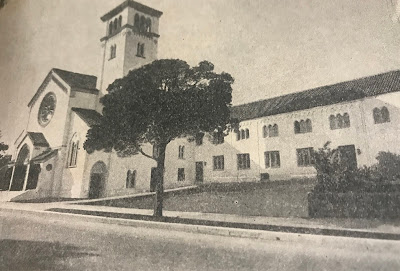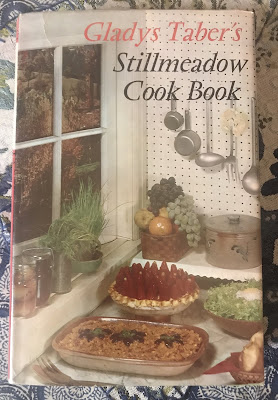The Philathea Cookbook
 |
| First Methodist Episcopal Church 1927. |
Thunderstorms are rolling through today and so I went to the cookbooks and pulled one down with the thought of writing a post for Beans Cookbook Legacy. I took it in hand and sat in the rocker by the window and started to read and after a time I understood why my Mother so enjoyed her cookbooks and why she would sit and read them like novels for hours. I have this image in my mind of women through time leafing through cookery books searching for something new and different. Or perhaps looking for a special recipe to make for a celebration or returning to an old tried and true one. I guess I’m old fashioned and I know I’m terribly sentimental but the experience of meandering through a cookbook, especially one that has been lovingly used for many years has a unique voice, an energy, and memories tucked within its pages.
 |
| Published 1928. |
 |
| The church is still in use today. |
Of all the cookbooks I’ve read in my life I have to say I’ve never gone through an entire book and really not found one single recipe that enticed me! A cookbook can be a window into a time period and frankly I was surprised by the minimal use of fresh fruits and vegetables used throughout especially since this congregation was in California. The first chapter is dedicated to “cocktails”, it’s one page and it has 6 recipes for crab, oyster, fruit, orange, watermelon and cantaloupe cocktails. Save the melons the recipes call for all canned fruit. Likewise the soups, 2 pages, call for canned vegetables save for small amounts of fresh onions and carrots. And I cannot imagine a tomato soup made with catsup and tomato juice mixed with melted Crisco shortening and flour for thickening! They loved their Crisco shortening throughout this cook book. Tamale pie must have been the “In” exotic dish for the cook book includes no less than six recipes. Likewise three recipes for Chop Suey and a large number of veal recipes. And they were fond of scalloping vegetables from corn, to onions, and tomatoes. Scalloping is the layering of sliced vegetable with buttered crumbs and or a white sauce and baked until browned. The salad chapter is overflowing with canned fruit, marshmallows maraschino cherries and jello molds.
In usual form of an older cookbook it is assumed that you already know how to cook so recipes are short on instructions, do not tell you oven temperatures or estimated times of baking. Though I find it rather charming to instruct the cook to boil 10 cents worth of spaghetti it doesn’t help now in 2020 as pasta is far from costing a dime a package but perhaps they could buy only what was needed.
Still, I can see why my mother was attracted to this particular cook book. Between each chapter there were blank pages left for the home cook to write in her favorites and most treasured recipes and Gladys Marker did just that. She also glued in clippings from newspapers, typed recipe pages, and jotted recipes and notes throughout the book. She often left a one word comment about recipes she had tried and even wrote recipes around and in between the advertisements. This is the treasure that my mother sought. Like a recipe Gladys wrote in on the top of the cocktails page for Spiced Cider; “juice 2 lemons, 4 oranges, 3 qts cider, 3/4 cup sugar. Put 1/2 tsp nutmeg, 1 tsp allspice, 1 tsp cloves, 4-2” cinnamon sticks in a bag. Bring to boil and serve. Her last note is that she would “ cut down on spices.”
A poem in the beginning of the book reads;
A Man’s Need
Man may live without
Poetry, Music and Art,
They may live without
Conscience and live without heart.
They may live without friends,
They may live without books,
But civilized man cannot
Live without cooks.
The book has a number of advertisements throughout (hence the fundraiser) of local businesses such as Trenwith’s featuring Granite Silk Stockings; Smith Bro’s. For Volrath a white porcelain enameled ware “it costs more but it is better”; and The Hughes instructing the ladies on the “recipe for an attractive woman” which begins “ walk briskly to 917 State St (their address) . There are also ads for Southern California Edison singing the praises of the new electric range and the new “Easy” washers.
So the recipes I finally chose to try were ones that I felt my mom Bean would have loved. She had a wicked sweet tooth. When asked as a young child if she had a sweet tooth she thought about it and then opened her mouth wide and pointed to all of them informing the person that all of her teeth were sweet teeth. Secondly besides sweets she adored her coffee. As I have mentioned in past posts she was a coffee connoisseur. So she would have happily sat down with a slice of this mocha cake with mocha frosting and a big mug of strong black coffee.
Mocha Cake as I made it...
2 cups flour 1/4 tsp cinnamon
3 tsp baking powder. 3/4 cup strong black coffee, cooled
1/2 tsp salt. 1/2 cup canola oil
1 1/4 cup sugar. 2 eggs
4 tsp cocoa powder. 1/2 tsp vanilla extract
Into a large bowl sift together all dry ingredients (including sugar) twice. In separate bowl mix together the coffee, oil, slightly beaten eggs and vanilla. Add to dry ingredients and beat well until combined and smooth. Pour into 2 round cake pans or one small Bundt pan that has been greased and floured. Bake at 350 degree oven for 30-35 minutes or until toothpick comes out clean.
I decided to use a second recipe from the cook book for mocha frosting.
1/4 cup softened butter. 2 tsp cocoa powder
1 cup confectioners sugar 2 tabs strong coffee
1/2 tsp vanilla
Whip all frosting ingredients together until smooth and fluffy. This one batch was enough to just top this small bundt cake so I’d suggest doubling or tripling the recipe if you wish to cover the cake completely or layer in between 2 layers. I also finely grated chocolate on top.
The cake is delicious, light with a nice crumb and sweet. Bean would have approved.
 |
| Mocha cake with mocha frosting. |








Comments
Post a Comment